Love this Bo Ssam (Korean Pork Roast Lettuce Wraps)? Check out our other fabulous Korean Food Recipes!
You and I both know that often times -when we want to try whipping up a popular ethnic food- the thing that stands between us and success is finding the dadburned ingredients to make it. Right? Maybe this isn’t so true if you, unlike me, live in a town with more people than cows or cornstalks…
But for those of us who choose to live a little further off the beaten path, our dreams of varied fare can be a little harder to achieve. Today, though, I am bringing you a classic Korean dish that tastes like a million bucks but costs under $20 to make. And wonder of wonders, I don’t even have to drive into the big city to get the ingredients. It starts with three basic ingredients: pork shoulder or butt roast (this may be because I’m the mother of five boys, but every time I say pork butt I giggle just a bit), sugar, and salt. Make that four ingredients. You also need time. I promise this isn’t about to become the “you need aeons and aeons to cook this dish” blog, but this is another one that you have to commit to for time although it requires very little in the way of hands-on time.
I’m just going to come right out and say it: you’re going to need about seven hours altogether to cook this. Break it down with me, though. There is going to be a grand total of about ten minutes- that’s 10 MINUTES!- of hands on time and that time is taken mixing salt and sugar together, rubbing it on the roast, transferring to another pan, mixing more sugar and salt, pouring it over the roast, putting it back in the oven, and taking it back out of the oven. That’s not even a little scary, is it? Granted, there are a few hours between some of those steps, but shoot… you can go do a load of laundry, go to church, go on a hike, take a nap, read a good book, or otherwise try not to chew on everything in your kitchen while it cooks, because
DANG!
…it smells really, insanely, painfully good. What makes it so ridiculously tempting? The night before you cook it, you rub it in a mixture of kosher salt and raw sugar. While we’re discussing sugar, please spring for the raw sugar here… or sucanat. Either will be good and either will make a heap-big difference in the end product over white sugar. TRUST ME! This sits, covered in plastic wrap, in the roasting pan you’ll be using to cook it the next day.
What kind of pan do I need?
Don’t use some vast, roomy, Thanksgiving turkey sized-roasting pan unless you have one mondo huge pork shoulder or pork butt (teehee). It’s too much, you want your pork butt (snicker) to be all cuddly and snug and tucked into a roasting pan. This may mean using a casserole dish as a roasting pan. That’s okay! The only other real issue you’ll want to consider when contemplating cooking vessels is that it needs to have high enough sides to come most of the way up the roast. Those pork roasts give off a ton of cooking juices and oil.
Can I substitute pork loin or tenderloin for the shoulder or butt roast?
Nope. I mean it. Negatory. Don’t do it. You NEED the fat in this dish. It is crucial. There’s no point in making this if you’re going to try to get away from the fat. You’re indulging. Do it right.
Why is this worth the nearly 7 hours of cooking time?
It’s pretty hard to describe the experience that is Bo Ssäm. I had laid it all out for the photos, and the guys were hovering in the hopes of hoovering quickly. I said, “If you guys want to try a little bit while I put the camera away, we’ll move it all to the table in a minute.”
It started with pulling a little bit of the sweet and salty, caramelized, crusty, outer-layer of the pork roast and piling it on a lettuce leaf with some hot, fresh, short-grain rice, a little bit of kimchi (homemade, of course! Future Post Alert!), a spoonful of Ginger Scallion Sauce (recipe included today!), and a squirt of Sriracha straight from the bottle.
I’m pretty sure my husband looked like one of those crazy Chinese dragons with the wild rolling eyes when he tried it. I rejoined them in the kitchen and my husband shoved a wrap in my hand. I ate it over the counter top. I am telling you that roast never made it off of the counter. We all stood there in the kitchen grabbing, piling, drizzling, and eating. We had juices running down our arms, and perma-grins plastered on our faces. It was a moment we will all remember. When we had all eaten ourselves silly, my husband turned to me and urged, “Make this again. Soon. Please. Often. Can we have this a lot?” The kids all nodded mutely with fervent expressions.
Need I say more?
Oh shoot. I DO need to say more. This made it onto the short list for entertaining meals. It’s been requested by two kids for birthday meals, for our annual Super Bowl feast, and -by my husband- to impress my father-in-law.
To read more about the origins of Bo Ssäm, click on through to Wikipedia.
One Final Note:
If you taste the roast before resting it and putting that final sugar cap on, you may think you’ve gone dreadfully wrong and created a pork salt-lick rather than a succulent dish. It is salty because that outer layer is what cured in the salt/sugar crust overnight. Don’t worry! Like many Korean meat dishes, it’s pretty salty when eaten alone but the level of saltiness drops dramatically when served with unsalted lettuce leaves, unsalted rice, kimchi, and Ginger Scallion sauce.
Besides this, my hubby insists I inform you that the inner meat -beyond that salty/sweet crust- is quite normal… Add some of the crispy, salty outside to the mild, succulent inside and it’s perfection! It’s brilliant, really, adding the salt to the meat helps preserve it longer and prevents you (theoretically anyway) from overeating it. When paired with everything else it is absolutely, unequivocally perfect. Amen.
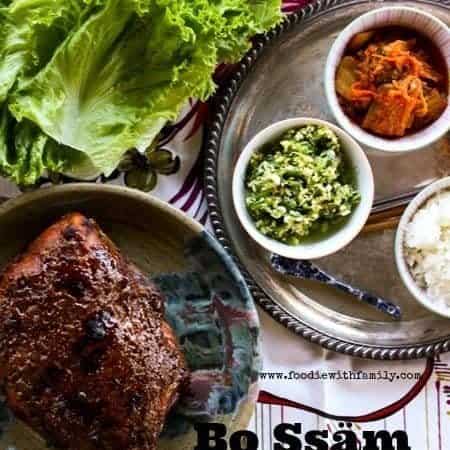
Bo Ssäm {Korean Pork Roast Lettuce Wraps} and Ginger Scallion Sauce Make Ahead Mondays
Rate RecipeIngredients
For the Bo Ssäm:
- Bone-in Pork Shoulder or Butt Roast *See Notes, between 4-11 pounds .
- 1 cup plus 1 tablespoon kosher salt divided
- 1 cup raw sugar or sucanat
- 1/2 cup brown sugar
For the Ginger Scallion Sauce:
- 3 bunches green onions scallions, root ends trimmed then sliced thinly
- 5 inch piece of fresh ginger root peeled and minced or finely grated
- 1/2 cup canola or grapeseed oil
- 1 teaspoon white wine vinegar or rice vinegar
- 1/2 teaspoon soy sauce
To Serve:
- Red or Green Leaf Lettuce removed from core, washed and dried thoroughly
- hot fresh, cooked short or medium grain rice
- kimchi
- Ginger Scallion Sauce
Instructions
The Night Before Cooking:
- Combine 1 cup of kosher salt with the cup of raw sugar or sucanat and rub all over the pork roast. Place it in a snug fitting, high-sided roasting pan, cover with plastic wrap and refrigerate overnight.
To Make the Ginger Scallion Sauce:
- Mix all of the ingredients together, cover, and refrigerate for at least 30 minutes or up to 4 days before serving.
To Cook the Bo Ssäm:
- Preheat oven to 300°F with a rack in the center.
- Pour off any liquid and excess salt/sugar that pooled under and around the pork and be sure that the pork roast is fat side up in the roasting pan. Place the pan -uncovered- in the oven and let roast for between 4 and 7 hours, basting about every hour or so with the fat that has pooled under it. You don't need to sweat this too much, if you miss an hour it won't be the end of your delicious roast. If you have a smaller roast, it will take less time to cook to the stage where it is so tender it almost falls apart when you move it. That is the goal. By the same token, if you have a larger roast, it will take longer. When you baste it, move it around a bit with tongs and see if it is yielding. When it reaches that stage of tenderness, remove the pan from the oven. Move the roast to a rimmed, small baking sheet and tent lightly with foil. Let it rest at room temperature for 30 to 60 minutes OR wrap tightly with plastic wrap and refrigerate at this point. You can keep the roast refrigerated for up to 3 days after the primary cook.
About an Hour Before Serving:
- If you refrigerated the roast, let it rest at room temperature 30 minutes.
- Preheat the oven to 500°F. If your oven doesn't go that high, preheat the broiler to HIGH. Use a fork to mix together the brown sugar and remaining tablespoon of kosher salt. Uncover the roast, sprinkle the brown sugar/salt mixture over the top and lightly press it into the meat with your hands. Put the roast in the hot oven. Watch it carefully because the sugar likes to burn easily. Remove the roast when the sugar has melted and caramelized into a sticky, dark crust on top of the pork. It may have some charred areas... this is fine!
- Let the pork rest on the pan for about 10 minutes before transferring to a serving platter.
- Serve hot, warm, or room temperature with as many of the suggested accompaniments as you possibly can!
Notes
Nutritional information is an estimate and provided to you as a courtesy. You should calculate the nutritional information with the actual ingredients used in your recipe using your preferred nutrition calculator.
did you make this recipe?
Make sure to tag @foodiewithfam on Instagram and #hashtag it #foodiewithfamily so I can check it out!
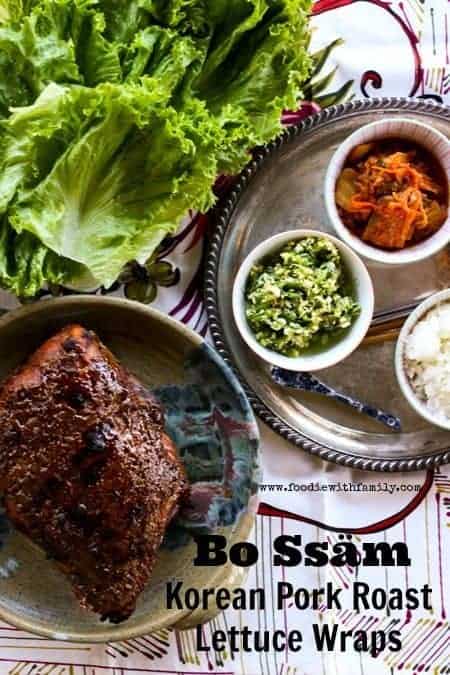
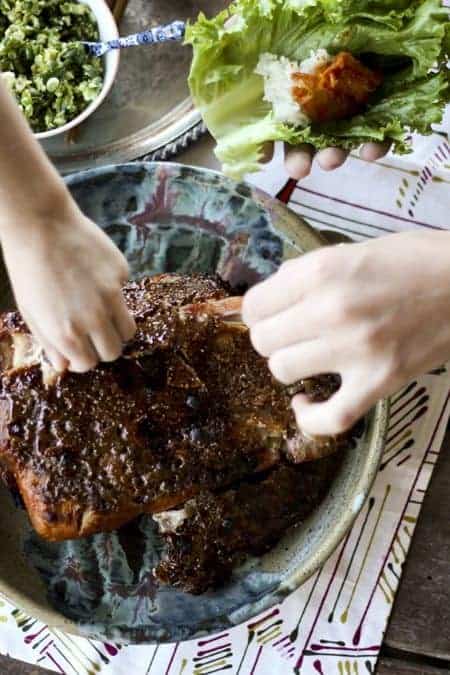
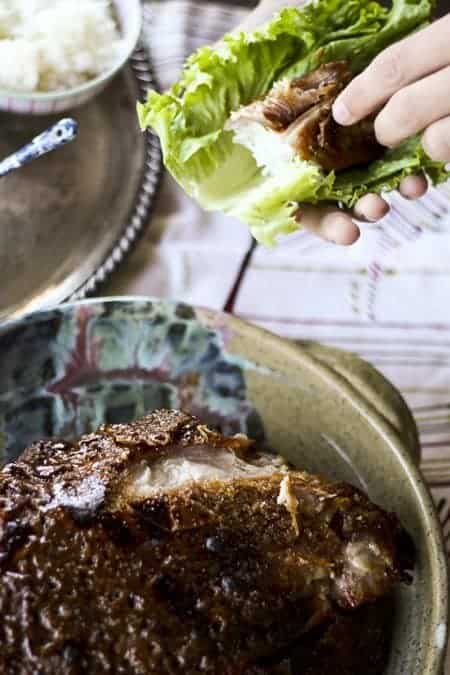
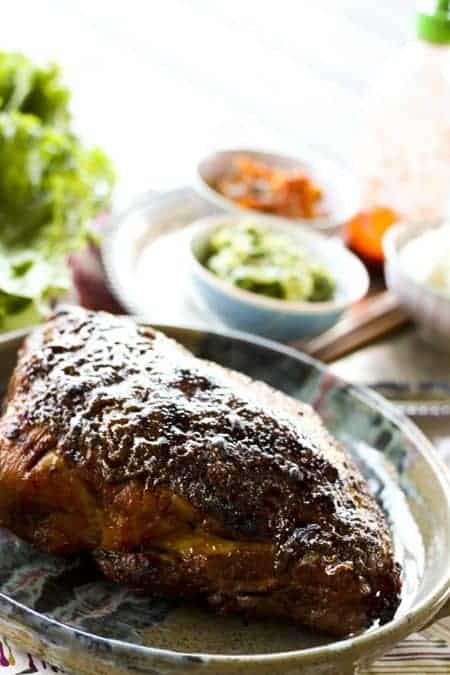



Reader's Thoughts...
Jerry says
In your experience when you put the meat in the fridge overnight prior to the final roast, that the 30 minutes of room temp thawing and the final step at the end would be enough to warm the whole piece of meat? I was initially planning on putting the meat back in the oven at a low temp to warm through and then doing the final step again
Rebecca says
Hi Jerry- It is absolutely enough time to warm it to the point it needs to be warmed for serving. 🙂 If you’d like it hotter, you can certainly leave it in the oven a little longer, but it’s just where I want it when I pull it out of the oven following these instructions.
Maija says
Hi, this looks amzing but I could only find pork shoulder with no bone. Will that work? Thanks!
Rebecca says
Hi Maija! I imagine it’ll work! You’ll want to keep an eye on the cooking time, though, as a cut without a bone will cook to doneness faster than one with a bone!